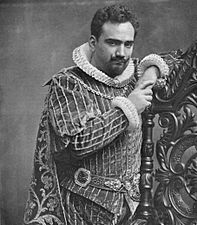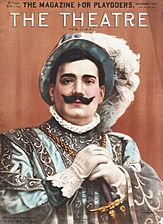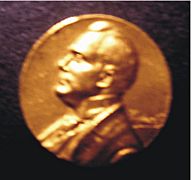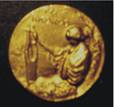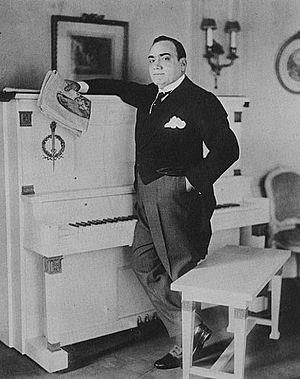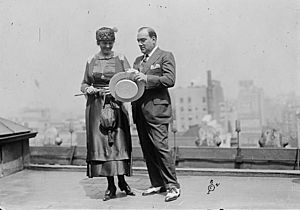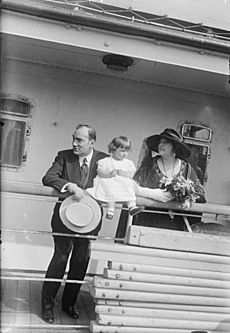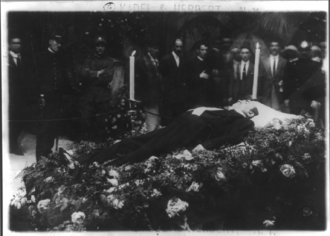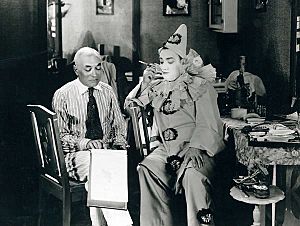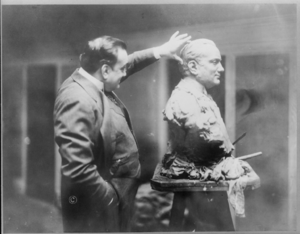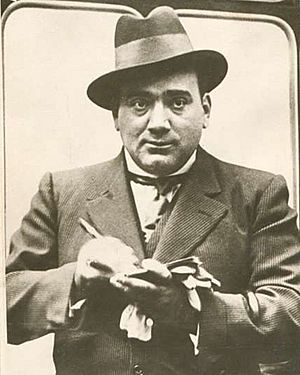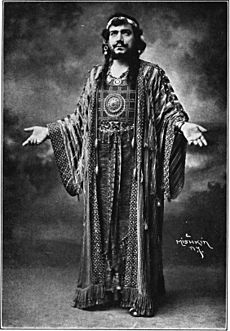Enrico Caruso facts for kids
Quick facts for kids
Enrico Caruso
|
|
|---|---|

Caruso around 1910
|
|
| Born | 25 February 1873 |
| Died | 2 August 1921 (aged 48) Naples, Kingdom of Italy
|
| Resting place | Cimitero di Santa Maria del Pianto |
| Occupation | lyric tenor, dramatic tenor |
| Years active | 1895–1920 |
| Spouse(s) |
Dorothy Park Benjamin
(m. 1918) |
| Partner(s) | Ada Giachetti (1898–1908) |
| Children | 5 |
| Signature | |
Enrico Caruso (born February 25, 1873 – died August 2, 1921) was a famous Italian opera singer. He was a tenor, which means he sang the highest male vocal parts in operas. He started as a lyric tenor, singing lighter, more beautiful roles, and later became a dramatic tenor, singing stronger, more powerful parts.
Caruso performed in many major opera houses in Europe and America. He sang in 74 different roles from Italian and French operas. He was also one of the first big singing stars to have his voice recorded. From 1902 to 1920, Caruso made 247 recordings. These recordings helped him become a huge international star in entertainment.
Contents
Biography
Early Life and Musical Start
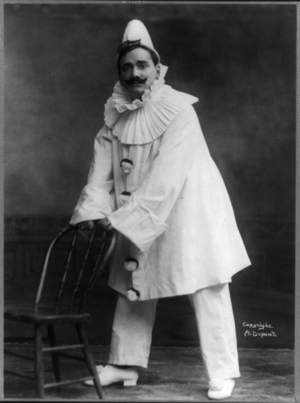
Enrico Caruso was born in Naples, Italy, on February 25, 1873. His family was not rich, but they were not extremely poor either. He was one of only three children in his family to survive past infancy.
His father, Marcellino, worked as a mechanic. When Enrico was 11, he started working with a mechanical engineer who built public water fountains. Later, he worked with his father in a factory. Enrico also went to school for a while and learned to write well and draw technical plans. He sang in his church choir, and people noticed his promising voice.
Caruso's mother encouraged his musical dreams. She passed away in 1888. To earn money for his family, Enrico sang on the streets of Naples and at cafes. When he was 18, he used the money he earned from singing to buy his first new pair of shoes. He also served 45 days in the military in 1894 before returning to his singing lessons.
Rising to Fame
On March 15, 1895, when he was 22, Caruso made his first professional stage appearance in an opera called L'Amico Francesco in Naples. After this, he sang in many smaller opera houses. A teacher named Vincenzo Lombardi helped him improve his high notes and singing style.
Money was still tight for young Caruso. Once, when visiting Sicily in 1896, he had to wear a bedspread like a toga for a publicity photo because his only dress shirt was being washed!
Towards the end of the 1800s, Caruso performed all over Italy. In 1900, he got a contract to sing at La Scala, a very famous opera house in Milan. His debut there was on December 26, 1900, in Giacomo Puccini's La bohème. He also sang in cities like Monte Carlo, Warsaw, and Buenos Aires. In 1899–1900, he even performed for the Tsar (emperor) of Russia in Saint Petersburg and Moscow.
Caruso created his first major opera role as Federico in L'arlesiana in 1897. He also created the role of Loris in Fedora in 1898 and Maurizio in Adriana Lecouvreur in 1902. The famous composer Puccini thought about casting Caruso in his opera Tosca in 1900. Puccini later said that Caruso sang the part even better than the original singer.
In February 1901, Caruso took part in a special concert at La Scala to honor the recently deceased composer Giuseppe Verdi. In December 1901, Caruso sang in Naples, his hometown, but the audience didn't seem to like his performance much. He was so upset that he promised never to sing in Naples again, saying he would only return "to eat a plate of spaghetti."
In March 1902, Caruso performed his last shows at La Scala. A month later, on April 11, he made his first recordings in a Milan hotel room. He was paid 100 pounds sterling for these ten songs. These recordings quickly became very popular and helped make Caruso famous around the world. The Royal Opera House in London then hired him for a season. His successful debut there was on May 14, 1902, in Verdi's Rigoletto. He often sang with the famous Australian soprano Nellie Melba.
Success at the Metropolitan Opera
In 1903, Caruso made his debut at the Metropolitan Opera in New York City. His first performance there was in Rigoletto on November 23, 1903. Just a few months later, he started working with the Victor Talking Machine Company. He made his first American recordings on February 1, 1904, after signing a very good deal with Victor. From then on, his recording career and his Met career grew together, making him even more famous.
-
Reverse: Euterpe, muse of music, with lyre
Caruso bought a large country house near Florence in 1904, called Villa Bellosguardo. It was his peaceful escape from his busy opera life. In New York City, he often stayed in a fancy suite at the Knickerbocker Hotel. He even had a special 24-carat-gold medal made by Tiffany & Co. to thank his agent, Pasquale Simonelli.
Besides his regular shows in New York, Caruso also performed in many other cities across the United States and in Canada. He continued to sing in Europe too, including in London, France, Belgium, and Germany, before World War I began.
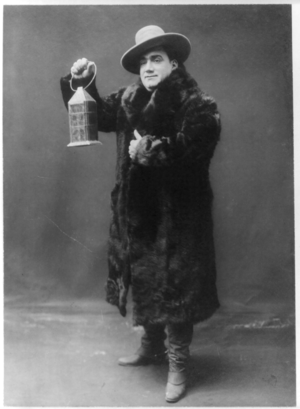
In April 1906, Caruso and other Met singers were in San Francisco for performances. On April 18, at 5:13 in the morning, a strong shake woke Caruso in his hotel room. He was in the middle of the San Francisco earthquake of 1906, which caused many fires and destroyed most of the city. Luckily, none of the singers were hurt. Caruso managed to leave the city by boat and then by train. He promised never to return to San Francisco and he kept his word.
Caruso was very popular with many people, not just the wealthy. Middle-class Americans also paid to hear him sing or buy his recordings. He had a large following among Italian immigrants in New York.
On December 10, 1910, Caruso created the role of Dick Johnson in the world premiere of Puccini's opera La fanciulla del West. Puccini wrote the music for Johnson specifically with Caruso's voice in mind.
Later Career and Family Life
As Caruso got older, his voice became deeper and more powerful. From 1916 onwards, he started singing more heroic roles like Samson and Eléazar. He toured South America in 1917 and Mexico City in 1919. In 1920, he was paid a huge sum of $10,000 a night to sing in Havana, Cuba.
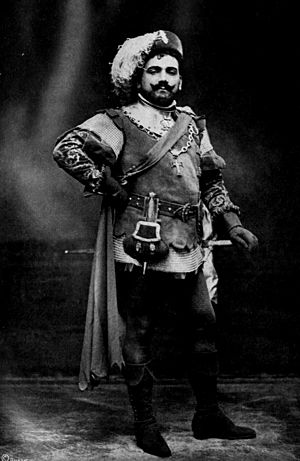
When the United States entered World War I in 1917, Caruso did a lot of charity work. He raised money for war efforts by giving concerts and helping with Liberty Bond drives. Caruso was also a smart businessman. He invested a lot of the money he earned from his recordings and performances. By the end of the war in 1918, his yearly income tax bill was $154,000.
Before World War I, Caruso had a relationship with an Italian soprano named Ada Giachetti. They had four sons together, but only two survived: Rodolfo and Enrico Caruso Jr. Their relationship ended after 11 years.
Towards the end of the war, Caruso met Dorothy Park Benjamin, a 25-year-old socialite. They got married on August 20, 1918, even though Dorothy's father didn't approve. They had a daughter named Gloria. Dorothy later wrote two books about Caruso, sharing many of his letters to her.
Caruso was very neat and took at least two baths a day. He loved good food and spending time with friends. He was very close with his fellow singer Antonio Scotti. Caruso was also superstitious and carried good-luck charms when he sang. For fun, he played cards and sketched his friends and other musicians. His wife said his favorite hobby was collecting scrapbooks. He also collected rare stamps, coins, watches, and old snuffboxes. Caruso smoked a lot of cigarettes, which, along with his busy performance schedule, might have contributed to his health problems later in life.
Illness and Passing
On September 16, 1920, Caruso finished his last recording sessions. He recorded several songs, including parts of Rossini's Petite messe solennelle.
Dorothy Caruso noticed her husband's health getting worse in late 1920. His son, Enrico Caruso Jr., believed his father's illness might have started when a falling prop hit him on stage during an opera performance on December 3. A few days later, Caruso got a chill and a cough, with a "dull pain in his side." Doctors first thought it was bronchitis or nerve pain.
During a performance on December 11, 1920, he had a throat bleed, and the show was stopped. After this, a very unwell Caruso only performed three more times at the Met. His very last performance was on December 24, 1920. By Christmas Day, the pain in his side was so bad he was screaming. Doctors finally diagnosed him with a serious lung infection called pleurisy and empyema.
Caruso's health got worse in the new year. He had intense pain and underwent seven surgeries to drain fluid from his chest and lungs. He slowly started to get better and returned to Naples in May 1921 to recover. However, his condition worsened dramatically after being examined by a local doctor. Doctors suggested removing his left kidney. He was on his way to Rome for this, but his condition got worse while staying overnight in a hotel in Naples.
Enrico Caruso passed away at the hotel on August 2, 1921, at the age of 48. The cause of death was a serious infection in his abdomen. The King of Italy allowed Caruso's funeral to be held in the Royal Basilica of the Church of San Francesco di Paola, and thousands of people attended. His body was preserved in a glass coffin for people to see. In 1929, his remains were permanently sealed in a stone tomb.
Historical Importance
Caruso's career lasted from 1895 to 1920. He performed 863 times with the New York Metropolitan Opera. Thanks to his incredibly popular phonograph records, Caruso was one of the most famous entertainers of his time. His fame has continued even today. He was one of the first global media celebrities. Beyond records, his name became known worldwide through newspapers, books, magazines, and new technologies like cinema, the telephone, and the telegraph.
Caruso traveled widely, performing hundreds of shows across Europe, North America, and South America. Many people, including singer Beverly Sills, have noted how amazing it was that Caruso became so famous without modern technology like TV and radio.
Caruso's biographers say his fame came not only from his voice but also from his good business sense and his willingness to use new sound recording technology. Many opera singers back then didn't like the phonograph because the sound quality wasn't great. But others, like Nellie Melba, started using it once they saw how much money Caruso was making from his recordings.
Caruso made over 260 recordings in America for the Victor Talking Machine Company from 1904 to 1920. He and his family earned millions of dollars from these record sales. He was also heard live from the Metropolitan Opera House stage in 1910, during the first public radio broadcast in the United States.
Caruso also appeared in two movies. In 1918, he played two roles in the American silent film My Cousin. This movie included a scene of him singing a famous opera song. The next year, he played a character in another film called The Splendid Romance. While he was paid a lot for these movies, My Cousin didn't do well, and The Splendid Romance was never released. Short videos of Caruso offstage have also been saved in old newsreels.
While Caruso sang at famous places like La Scala in Milan and the Royal Opera House in London, he performed most often at the Metropolitan Opera in New York City. He was the main tenor there for 18 years in a row.
Caruso's voice could reach very high notes and became stronger as he got older. Sometimes, his voice sounded deep, almost like a baritone. He sang many different types of roles, from light and lyrical to powerful and dramatic, in Italian and French operas.
Honors
During his life, Caruso received many awards and honors from kings, governments, and cultural groups in the countries where he sang. He also received Italian knighthoods. In 1917, he became an honorary member of the Phi Mu Alpha Sinfonia, a music fraternity. He was even made an "Honorary Captain of the New York Police Force."
In 1960, Caruso received a star on the Hollywood Walk of Fame for his contributions to the recording industry. In 1987, he was given a Grammy Lifetime Achievement Award after his death. On February 27 of that same year, the United States Postal Service issued a postage stamp in his honor. In 2012, he was voted into Gramophone magazine's Hall of Fame.
Operatic Roles
Caruso's opera roles were mostly Italian, with a few French ones. Early in his career, he also sang two German operas, but in Italian. Below are the first times Caruso performed each opera on stage, in order. New operas that premiered with him are marked with a **.
- L'amico Francesco (Morelli) – Naples, March 15, 1895 (debut)**
- Faust – Caserta, March 28, 1895
- Cavalleria rusticana – Caserta, April 1895
- Camoens (Musoni) – Caserta, May 1895
- Rigoletto – Naples, July 21, 1895
- La traviata – Naples, August 25, 1895
- Lucia di Lammermoor – Cairo, October 30, 1895
- La Gioconda – Cairo, November 9, 1895
- Manon Lescaut – Cairo, November 15, 1895
- I Capuleti e i Montecchi – Naples, December 7, 1895
- Malia (Francesco Paolo Frontini) – Trapani, March 21, 1896
- La sonnambula – Trapani, March 25, 1896
- Mariedda (Gianni Bucceri) – Naples, June 23, 1896
- I puritani – Salerno, September 10, 1896
- La Favorita – Salerno, November 22, 1896
- A San Francisco (Sebastiani) – Salerno, November 23, 1896
- Carmen – Salerno, December 6, 1896
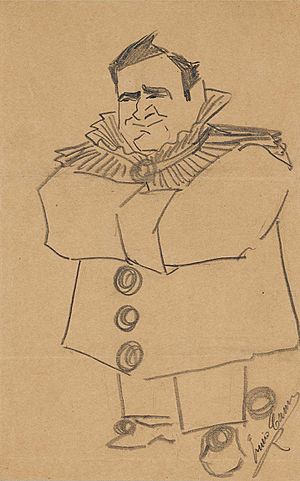
- Un Dramma in vendemmia (Fornari) – Naples, February 1, 1897
- Celeste (Marengo) – Naples, March 6, 1897**
- Il Profeta Velato (Napolitano) – Salerno, April 8, 1897
- La bohème – Livorno, August 14, 1897
- La Navarrese – Milan, November 3, 1897
- Il Voto (Giordano) – Milan, November 10, 1897**
- L'arlesiana – Milan, November 27, 1897**
- Pagliacci – Milan, December 31, 1897
- La bohème (Leoncavallo) – Genoa, January 20, 1898
- The Pearl Fishers – Genoa, February 3, 1898
- Hedda (Leborne) – Milan, April 2, 1898**
- Mefistofele – Fiume, March 4, 1898
- Sapho (Massenet) – Trento, June 3, 1898
- Fedora – Milan, November 17, 1898**
- Iris – Buenos Aires, June 22, 1899
- La regina di Saba (Goldmark) – Buenos Aires, July 4, 1899
- Yupanki (Berutti)– Buenos Aires, July 25, 1899**
- Aida – St. Petersburg, January 3, 1900
- Un ballo in maschera – St. Petersburg, January 11, 1900
- Maria di Rohan – St. Petersburg, March 2, 1900
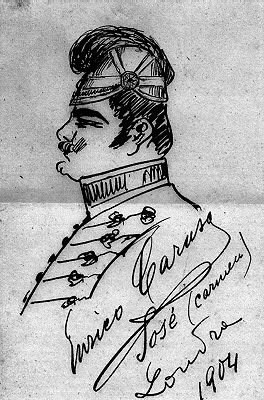
- Manon – Buenos Aires, July 28, 1900
- Tosca – Treviso, October 23, 1900
- Le maschere (Mascagni) – Milan, January 17, 1901**
- L'elisir d'amore – Milan, February 17, 1901
- Lohengrin – Buenos Aires, July 7, 1901
- Germania – Milan, March 11, 1902**
- Don Giovanni – London, July 19, 1902
- Adriana Lecouvreur – Milan, November 6, 1902**
- Lucrezia Borgia – Lisbon, March 10, 1903
- Les Huguenots – New York, February 3, 1905
- Martha – New York, February 9, 1906
- Madama Butterfly – London, May 26, 1906
- L'Africana – New York, January 11, 1907
- Andrea Chénier – London, July 20, 1907
- Il trovatore – New York, February 26, 1908
- Armide – New York, November 14, 1910
- La fanciulla del West – New York, December 10, 1910**
- Julien – New York, December 26, 1914
- Samson et Dalila – New York, November 24, 1916
- Lodoletta – Buenos Aires, July 29, 1917
- Le prophète – New York, February 7, 1918
- L'amore dei tre re – New York, March 14, 1918
- La forza del destino – New York, November 15, 1918
- La Juive – New York, November 22, 1919
Caruso also knew over 500 songs. These included classical pieces, traditional Italian songs, and popular tunes of his time.
Recordings
Caruso's voice was perfect for recording. It was "manly and powerful, yet sweet and lyrical." He was one of the first major classical singers to make many recordings. Caruso and the phonograph (also called a gramophone) helped each other become popular in the early 1900s. Many of Caruso's recordings are still available today, over a century later. All his surviving recordings have been cleaned up and re-released many times. Even though full opera recordings were available, Caruso never recorded a complete opera.
Caruso's first recordings were made in Milan in 1902. He recorded with piano music for the Gramophone & Typewriter Limited company. In 1903, he made more recordings in Milan for another company. On February 1, 1904, Caruso made his first recordings in America for the Victor Talking Machine Company. After that, he recorded only for Victor. Most of his American recordings were made in Victor's studios in New York and New Jersey. His very last recording session was on September 16, 1920.
Caruso's earliest Victor records from 1904-1905 were all with piano. But from February 1906, orchestras started to be used for his recordings. Later, some of his older recordings were re-released with new, larger orchestra sounds added to them.
Caruso recorded with many famous female singers, including Nellie Melba, Geraldine Farrar, and Amelita Galli-Curci.
In the 1970s, a new computer technique was used to improve the sound of Caruso's recordings for RCA. This helped reduce some of the old noises from the early records. Later, all of Caruso's complete recordings were released on CDs. Since the original copyrights expired, Caruso's records are now free to be used by anyone. They are also available online. His most popular songs downloaded on iTunes have been the Italian folk songs "Santa Lucia" and "'O sole mio".
Caruso passed away before the invention of better, electrical recording technology in 1925. All his recordings were made using an older method. This method required the singer to sing into a metal horn, which sent the sound directly to a wax disc. This old process could only capture a limited range of his voice. Also, his records could only hold about four and a half minutes of music. So, most of the songs he recorded had to be short or edited to fit.
Images for kids
-
Caruso's sketch of himself as Canio in Pagliacci, around 1900
-
Caruso's sketch of himself as Don José in Carmen, 1904
See also
 In Spanish: Enrico Caruso para niños
In Spanish: Enrico Caruso para niños


